Leading Strategic Decision Making: Unilever and Porter's Framework
VerifiedAdded on 2022/03/02
|14
|2934
|45
Report
AI Summary
This report offers a detailed analysis of Unilever's business strategy, focusing on its application of Porter's Generic Strategies framework. It begins with an overview of the framework and a descriptive analysis of Unilever's approach, including its business model and how it seeks competitive advantages through differentiation. The report critically evaluates the framework's benefits and limitations, providing recommendations to overcome these constraints. It then explores the Bowman's Strategy Clock as an alternative model. The report concludes with an overview of Unilever's strategic decisions in the international market.
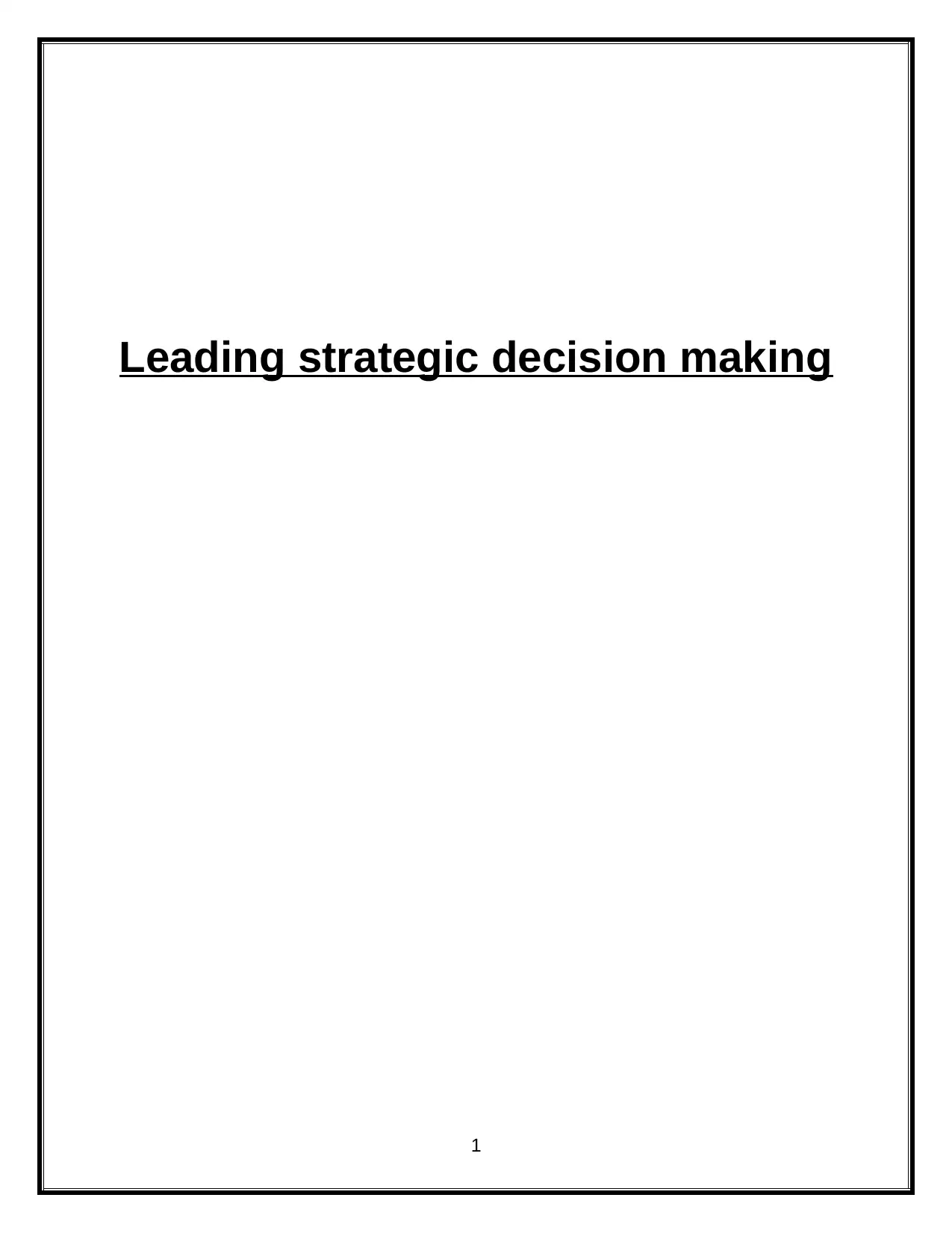
Leading strategic decision making
1
1
Paraphrase This Document
Need a fresh take? Get an instant paraphrase of this document with our AI Paraphraser
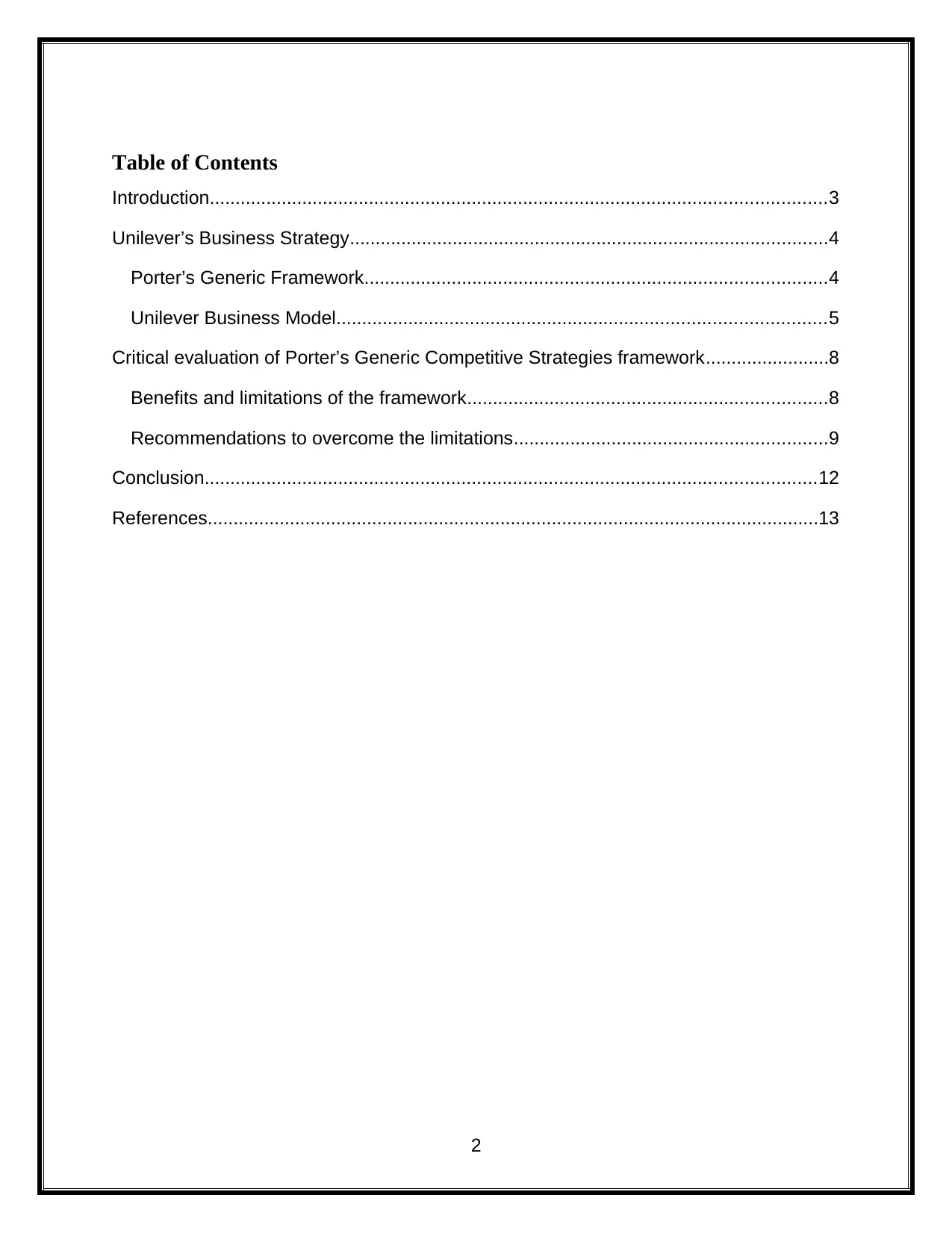
Table of Contents
Introduction........................................................................................................................3
Unilever’s Business Strategy.............................................................................................4
Porter’s Generic Framework..........................................................................................4
Unilever Business Model...............................................................................................5
Critical evaluation of Porter’s Generic Competitive Strategies framework........................8
Benefits and limitations of the framework......................................................................8
Recommendations to overcome the limitations.............................................................9
Conclusion.......................................................................................................................12
References.......................................................................................................................13
2
Introduction........................................................................................................................3
Unilever’s Business Strategy.............................................................................................4
Porter’s Generic Framework..........................................................................................4
Unilever Business Model...............................................................................................5
Critical evaluation of Porter’s Generic Competitive Strategies framework........................8
Benefits and limitations of the framework......................................................................8
Recommendations to overcome the limitations.............................................................9
Conclusion.......................................................................................................................12
References.......................................................................................................................13
2
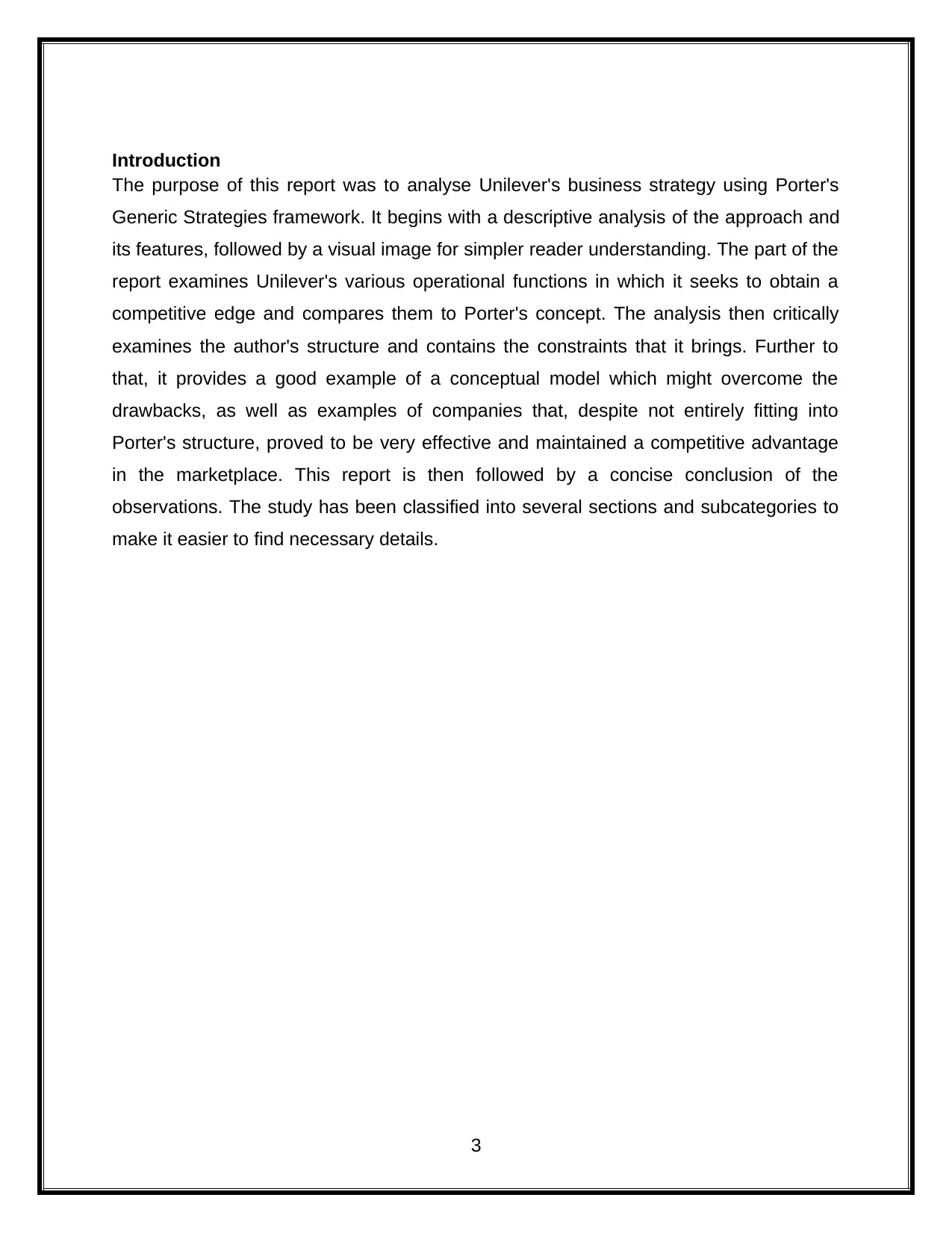
Introduction
The purpose of this report was to analyse Unilever's business strategy using Porter's
Generic Strategies framework. It begins with a descriptive analysis of the approach and
its features, followed by a visual image for simpler reader understanding. The part of the
report examines Unilever's various operational functions in which it seeks to obtain a
competitive edge and compares them to Porter's concept. The analysis then critically
examines the author's structure and contains the constraints that it brings. Further to
that, it provides a good example of a conceptual model which might overcome the
drawbacks, as well as examples of companies that, despite not entirely fitting into
Porter's structure, proved to be very effective and maintained a competitive advantage
in the marketplace. This report is then followed by a concise conclusion of the
observations. The study has been classified into several sections and subcategories to
make it easier to find necessary details.
3
The purpose of this report was to analyse Unilever's business strategy using Porter's
Generic Strategies framework. It begins with a descriptive analysis of the approach and
its features, followed by a visual image for simpler reader understanding. The part of the
report examines Unilever's various operational functions in which it seeks to obtain a
competitive edge and compares them to Porter's concept. The analysis then critically
examines the author's structure and contains the constraints that it brings. Further to
that, it provides a good example of a conceptual model which might overcome the
drawbacks, as well as examples of companies that, despite not entirely fitting into
Porter's structure, proved to be very effective and maintained a competitive advantage
in the marketplace. This report is then followed by a concise conclusion of the
observations. The study has been classified into several sections and subcategories to
make it easier to find necessary details.
3
⊘ This is a preview!⊘
Do you want full access?
Subscribe today to unlock all pages.

Trusted by 1+ million students worldwide
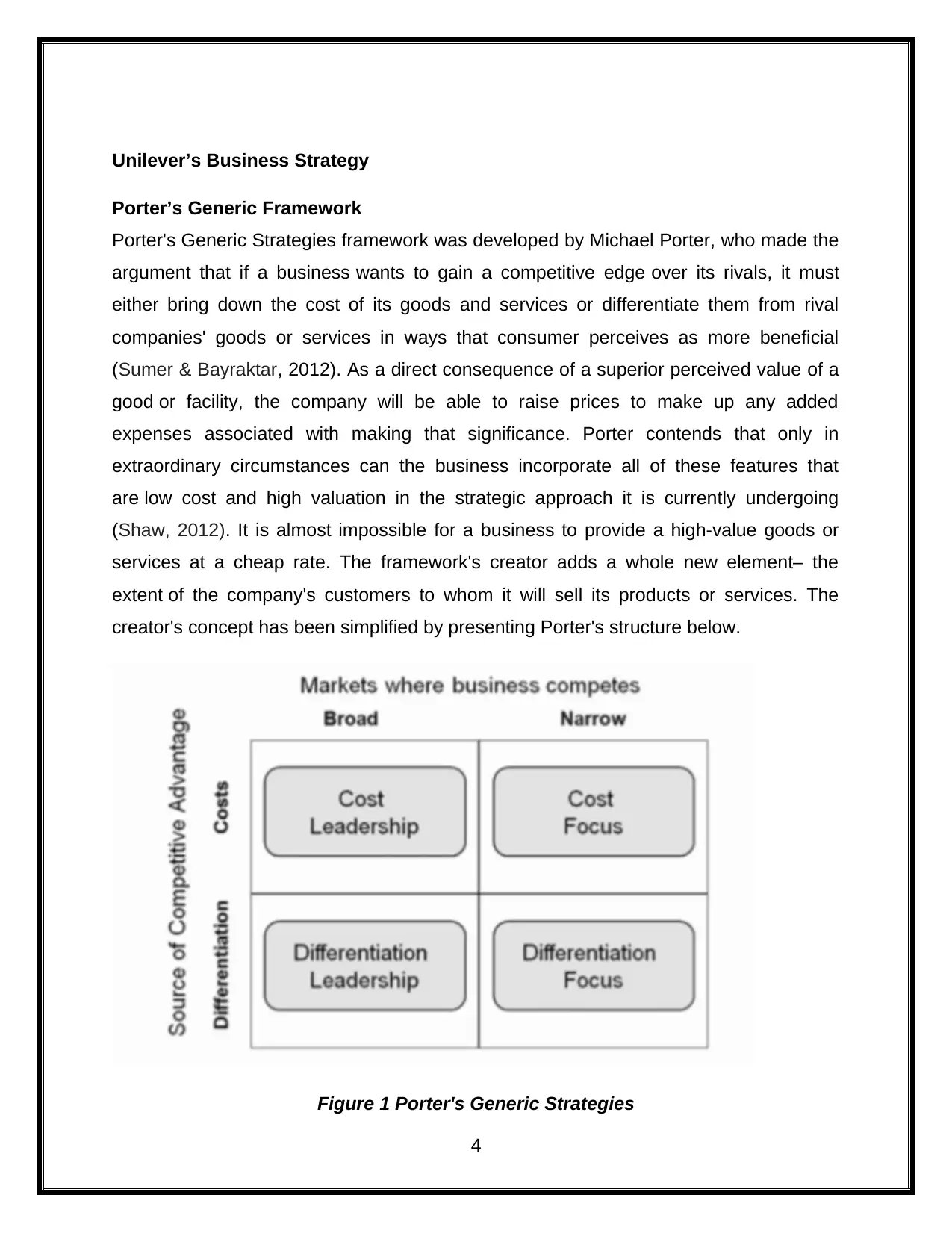
Unilever’s Business Strategy
Porter’s Generic Framework
Porter's Generic Strategies framework was developed by Michael Porter, who made the
argument that if a business wants to gain a competitive edge over its rivals, it must
either bring down the cost of its goods and services or differentiate them from rival
companies' goods or services in ways that consumer perceives as more beneficial
(Sumer & Bayraktar, 2012). As a direct consequence of a superior perceived value of a
good or facility, the company will be able to raise prices to make up any added
expenses associated with making that significance. Porter contends that only in
extraordinary circumstances can the business incorporate all of these features that
are low cost and high valuation in the strategic approach it is currently undergoing
(Shaw, 2012). It is almost impossible for a business to provide a high-value goods or
services at a cheap rate. The framework's creator adds a whole new element– the
extent of the company's customers to whom it will sell its products or services. The
creator's concept has been simplified by presenting Porter's structure below.
Figure 1 Porter's Generic Strategies
4
Porter’s Generic Framework
Porter's Generic Strategies framework was developed by Michael Porter, who made the
argument that if a business wants to gain a competitive edge over its rivals, it must
either bring down the cost of its goods and services or differentiate them from rival
companies' goods or services in ways that consumer perceives as more beneficial
(Sumer & Bayraktar, 2012). As a direct consequence of a superior perceived value of a
good or facility, the company will be able to raise prices to make up any added
expenses associated with making that significance. Porter contends that only in
extraordinary circumstances can the business incorporate all of these features that
are low cost and high valuation in the strategic approach it is currently undergoing
(Shaw, 2012). It is almost impossible for a business to provide a high-value goods or
services at a cheap rate. The framework's creator adds a whole new element– the
extent of the company's customers to whom it will sell its products or services. The
creator's concept has been simplified by presenting Porter's structure below.
Figure 1 Porter's Generic Strategies
4
Paraphrase This Document
Need a fresh take? Get an instant paraphrase of this document with our AI Paraphraser
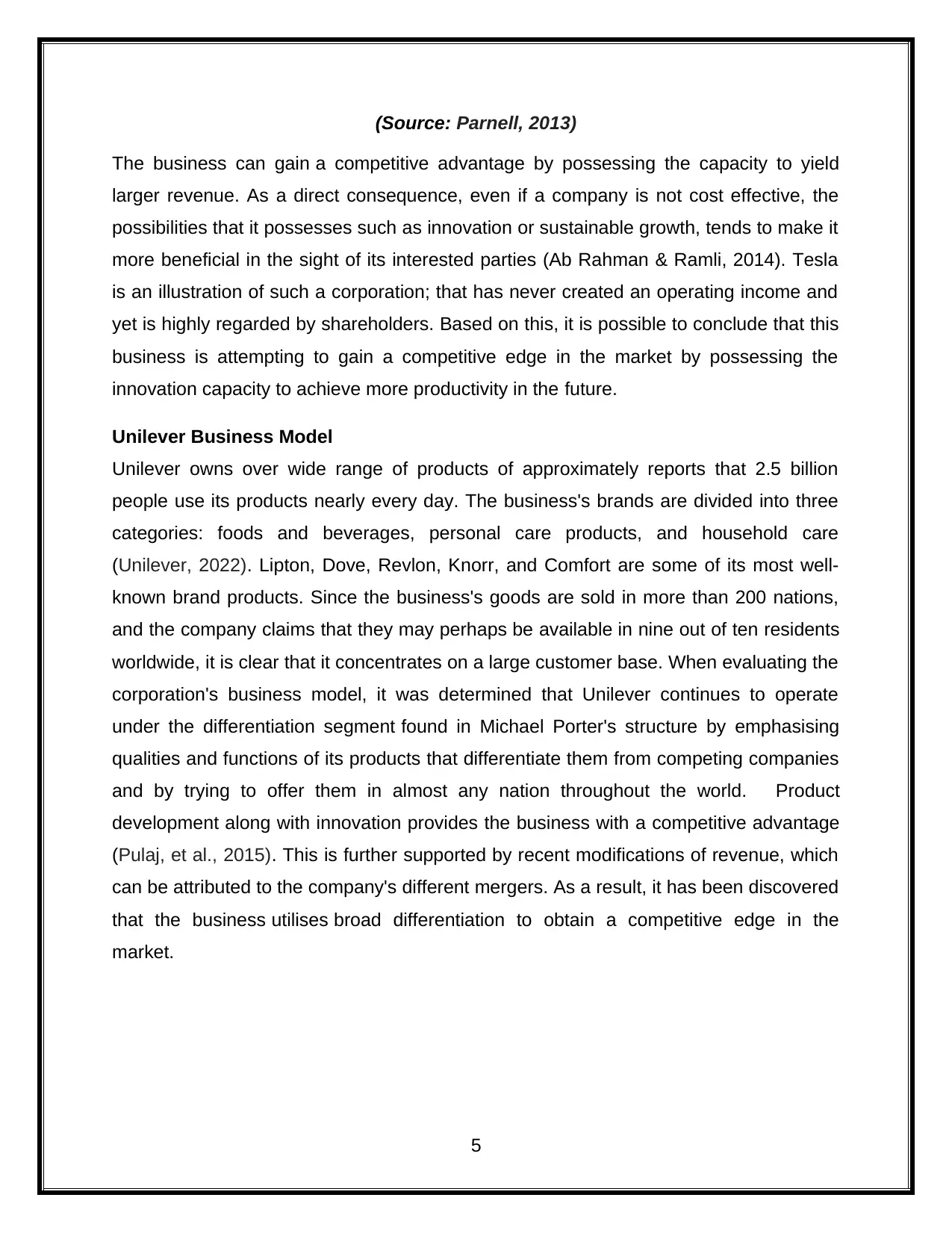
(Source: Parnell, 2013)
The business can gain a competitive advantage by possessing the capacity to yield
larger revenue. As a direct consequence, even if a company is not cost effective, the
possibilities that it possesses such as innovation or sustainable growth, tends to make it
more beneficial in the sight of its interested parties (Ab Rahman & Ramli, 2014). Tesla
is an illustration of such a corporation; that has never created an operating income and
yet is highly regarded by shareholders. Based on this, it is possible to conclude that this
business is attempting to gain a competitive edge in the market by possessing the
innovation capacity to achieve more productivity in the future.
Unilever Business Model
Unilever owns over wide range of products of approximately reports that 2.5 billion
people use its products nearly every day. The business's brands are divided into three
categories: foods and beverages, personal care products, and household care
(Unilever, 2022). Lipton, Dove, Revlon, Knorr, and Comfort are some of its most well-
known brand products. Since the business's goods are sold in more than 200 nations,
and the company claims that they may perhaps be available in nine out of ten residents
worldwide, it is clear that it concentrates on a large customer base. When evaluating the
corporation's business model, it was determined that Unilever continues to operate
under the differentiation segment found in Michael Porter's structure by emphasising
qualities and functions of its products that differentiate them from competing companies
and by trying to offer them in almost any nation throughout the world. Product
development along with innovation provides the business with a competitive advantage
(Pulaj, et al., 2015). This is further supported by recent modifications of revenue, which
can be attributed to the company's different mergers. As a result, it has been discovered
that the business utilises broad differentiation to obtain a competitive edge in the
market.
5
The business can gain a competitive advantage by possessing the capacity to yield
larger revenue. As a direct consequence, even if a company is not cost effective, the
possibilities that it possesses such as innovation or sustainable growth, tends to make it
more beneficial in the sight of its interested parties (Ab Rahman & Ramli, 2014). Tesla
is an illustration of such a corporation; that has never created an operating income and
yet is highly regarded by shareholders. Based on this, it is possible to conclude that this
business is attempting to gain a competitive edge in the market by possessing the
innovation capacity to achieve more productivity in the future.
Unilever Business Model
Unilever owns over wide range of products of approximately reports that 2.5 billion
people use its products nearly every day. The business's brands are divided into three
categories: foods and beverages, personal care products, and household care
(Unilever, 2022). Lipton, Dove, Revlon, Knorr, and Comfort are some of its most well-
known brand products. Since the business's goods are sold in more than 200 nations,
and the company claims that they may perhaps be available in nine out of ten residents
worldwide, it is clear that it concentrates on a large customer base. When evaluating the
corporation's business model, it was determined that Unilever continues to operate
under the differentiation segment found in Michael Porter's structure by emphasising
qualities and functions of its products that differentiate them from competing companies
and by trying to offer them in almost any nation throughout the world. Product
development along with innovation provides the business with a competitive advantage
(Pulaj, et al., 2015). This is further supported by recent modifications of revenue, which
can be attributed to the company's different mergers. As a result, it has been discovered
that the business utilises broad differentiation to obtain a competitive edge in the
market.
5
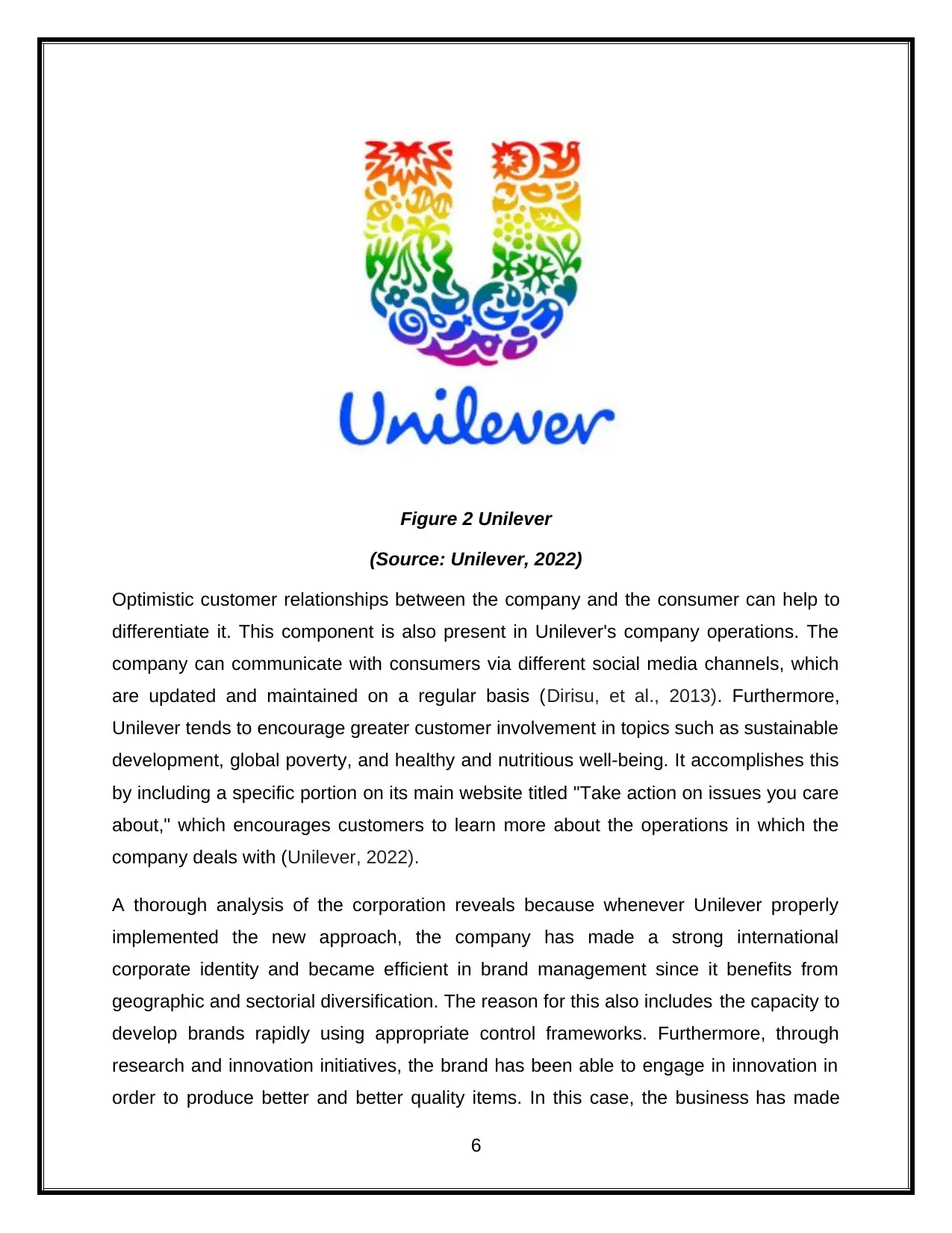
Figure 2 Unilever
(Source: Unilever, 2022)
Optimistic customer relationships between the company and the consumer can help to
differentiate it. This component is also present in Unilever's company operations. The
company can communicate with consumers via different social media channels, which
are updated and maintained on a regular basis (Dirisu, et al., 2013). Furthermore,
Unilever tends to encourage greater customer involvement in topics such as sustainable
development, global poverty, and healthy and nutritious well-being. It accomplishes this
by including a specific portion on its main website titled "Take action on issues you care
about," which encourages customers to learn more about the operations in which the
company deals with (Unilever, 2022).
A thorough analysis of the corporation reveals because whenever Unilever properly
implemented the new approach, the company has made a strong international
corporate identity and became efficient in brand management since it benefits from
geographic and sectorial diversification. The reason for this also includes the capacity to
develop brands rapidly using appropriate control frameworks. Furthermore, through
research and innovation initiatives, the brand has been able to engage in innovation in
order to produce better and better quality items. In this case, the business has made
6
(Source: Unilever, 2022)
Optimistic customer relationships between the company and the consumer can help to
differentiate it. This component is also present in Unilever's company operations. The
company can communicate with consumers via different social media channels, which
are updated and maintained on a regular basis (Dirisu, et al., 2013). Furthermore,
Unilever tends to encourage greater customer involvement in topics such as sustainable
development, global poverty, and healthy and nutritious well-being. It accomplishes this
by including a specific portion on its main website titled "Take action on issues you care
about," which encourages customers to learn more about the operations in which the
company deals with (Unilever, 2022).
A thorough analysis of the corporation reveals because whenever Unilever properly
implemented the new approach, the company has made a strong international
corporate identity and became efficient in brand management since it benefits from
geographic and sectorial diversification. The reason for this also includes the capacity to
develop brands rapidly using appropriate control frameworks. Furthermore, through
research and innovation initiatives, the brand has been able to engage in innovation in
order to produce better and better quality items. In this case, the business has made
6
⊘ This is a preview!⊘
Do you want full access?
Subscribe today to unlock all pages.

Trusted by 1+ million students worldwide
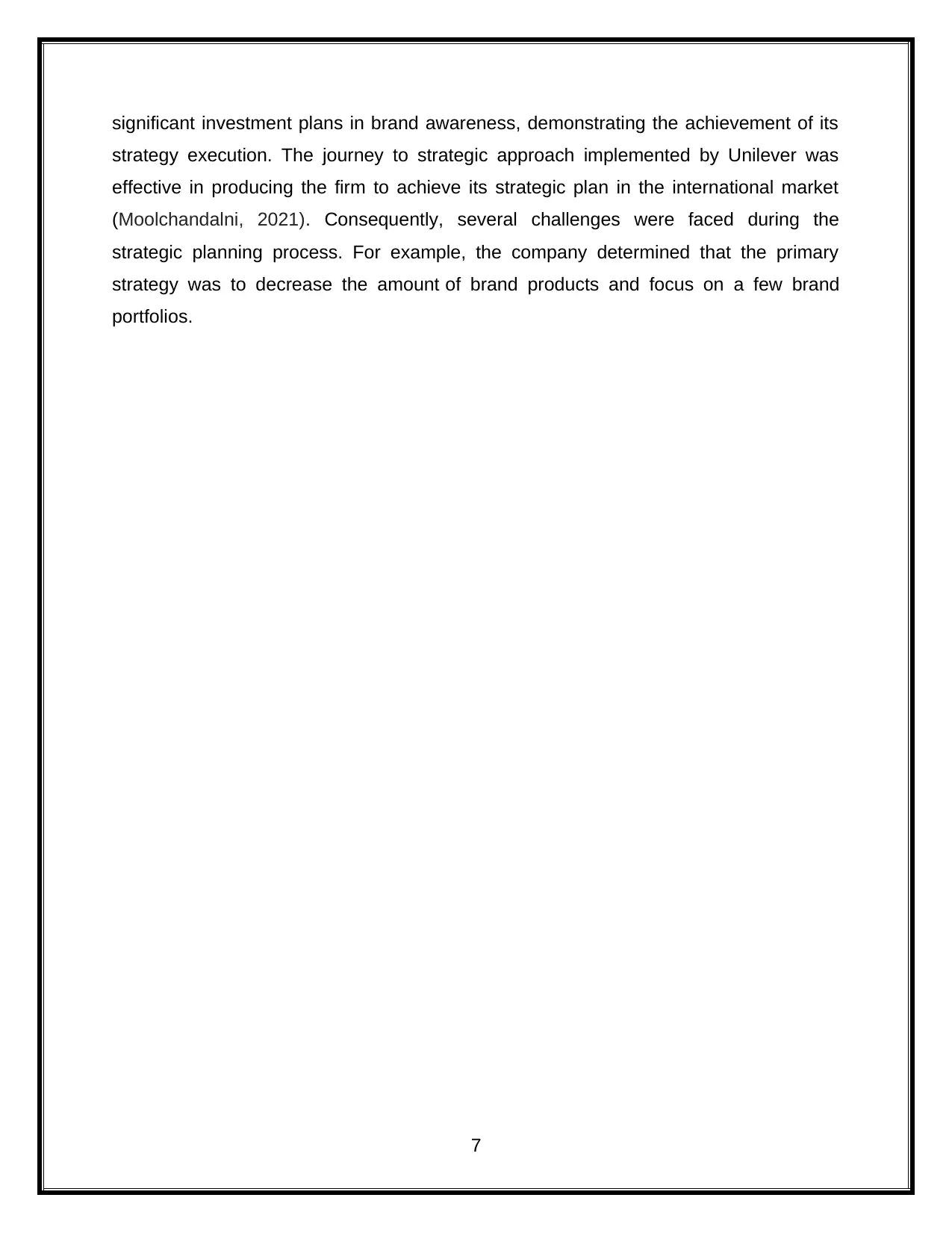
significant investment plans in brand awareness, demonstrating the achievement of its
strategy execution. The journey to strategic approach implemented by Unilever was
effective in producing the firm to achieve its strategic plan in the international market
(Moolchandalni, 2021). Consequently, several challenges were faced during the
strategic planning process. For example, the company determined that the primary
strategy was to decrease the amount of brand products and focus on a few brand
portfolios.
7
strategy execution. The journey to strategic approach implemented by Unilever was
effective in producing the firm to achieve its strategic plan in the international market
(Moolchandalni, 2021). Consequently, several challenges were faced during the
strategic planning process. For example, the company determined that the primary
strategy was to decrease the amount of brand products and focus on a few brand
portfolios.
7
Paraphrase This Document
Need a fresh take? Get an instant paraphrase of this document with our AI Paraphraser
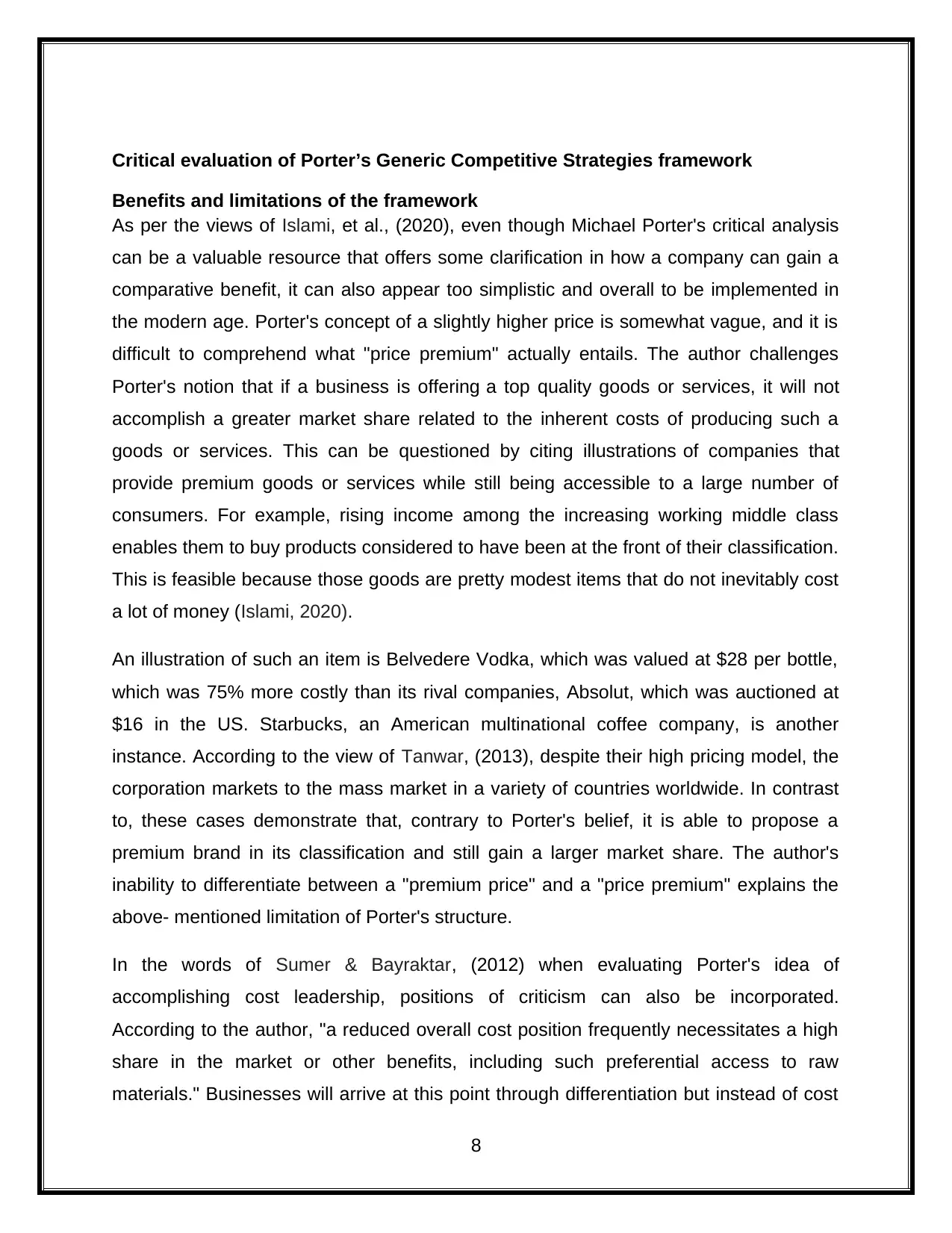
Critical evaluation of Porter’s Generic Competitive Strategies framework
Benefits and limitations of the framework
As per the views of Islami, et al., (2020), even though Michael Porter's critical analysis
can be a valuable resource that offers some clarification in how a company can gain a
comparative benefit, it can also appear too simplistic and overall to be implemented in
the modern age. Porter's concept of a slightly higher price is somewhat vague, and it is
difficult to comprehend what "price premium" actually entails. The author challenges
Porter's notion that if a business is offering a top quality goods or services, it will not
accomplish a greater market share related to the inherent costs of producing such a
goods or services. This can be questioned by citing illustrations of companies that
provide premium goods or services while still being accessible to a large number of
consumers. For example, rising income among the increasing working middle class
enables them to buy products considered to have been at the front of their classification.
This is feasible because those goods are pretty modest items that do not inevitably cost
a lot of money (Islami, 2020).
An illustration of such an item is Belvedere Vodka, which was valued at $28 per bottle,
which was 75% more costly than its rival companies, Absolut, which was auctioned at
$16 in the US. Starbucks, an American multinational coffee company, is another
instance. According to the view of Tanwar, (2013), despite their high pricing model, the
corporation markets to the mass market in a variety of countries worldwide. In contrast
to, these cases demonstrate that, contrary to Porter's belief, it is able to propose a
premium brand in its classification and still gain a larger market share. The author's
inability to differentiate between a "premium price" and a "price premium" explains the
above- mentioned limitation of Porter's structure.
In the words of Sumer & Bayraktar, (2012) when evaluating Porter's idea of
accomplishing cost leadership, positions of criticism can also be incorporated.
According to the author, "a reduced overall cost position frequently necessitates a high
share in the market or other benefits, including such preferential access to raw
materials." Businesses will arrive at this point through differentiation but instead of cost
8
Benefits and limitations of the framework
As per the views of Islami, et al., (2020), even though Michael Porter's critical analysis
can be a valuable resource that offers some clarification in how a company can gain a
comparative benefit, it can also appear too simplistic and overall to be implemented in
the modern age. Porter's concept of a slightly higher price is somewhat vague, and it is
difficult to comprehend what "price premium" actually entails. The author challenges
Porter's notion that if a business is offering a top quality goods or services, it will not
accomplish a greater market share related to the inherent costs of producing such a
goods or services. This can be questioned by citing illustrations of companies that
provide premium goods or services while still being accessible to a large number of
consumers. For example, rising income among the increasing working middle class
enables them to buy products considered to have been at the front of their classification.
This is feasible because those goods are pretty modest items that do not inevitably cost
a lot of money (Islami, 2020).
An illustration of such an item is Belvedere Vodka, which was valued at $28 per bottle,
which was 75% more costly than its rival companies, Absolut, which was auctioned at
$16 in the US. Starbucks, an American multinational coffee company, is another
instance. According to the view of Tanwar, (2013), despite their high pricing model, the
corporation markets to the mass market in a variety of countries worldwide. In contrast
to, these cases demonstrate that, contrary to Porter's belief, it is able to propose a
premium brand in its classification and still gain a larger market share. The author's
inability to differentiate between a "premium price" and a "price premium" explains the
above- mentioned limitation of Porter's structure.
In the words of Sumer & Bayraktar, (2012) when evaluating Porter's idea of
accomplishing cost leadership, positions of criticism can also be incorporated.
According to the author, "a reduced overall cost position frequently necessitates a high
share in the market or other benefits, including such preferential access to raw
materials." Businesses will arrive at this point through differentiation but instead of cost
8
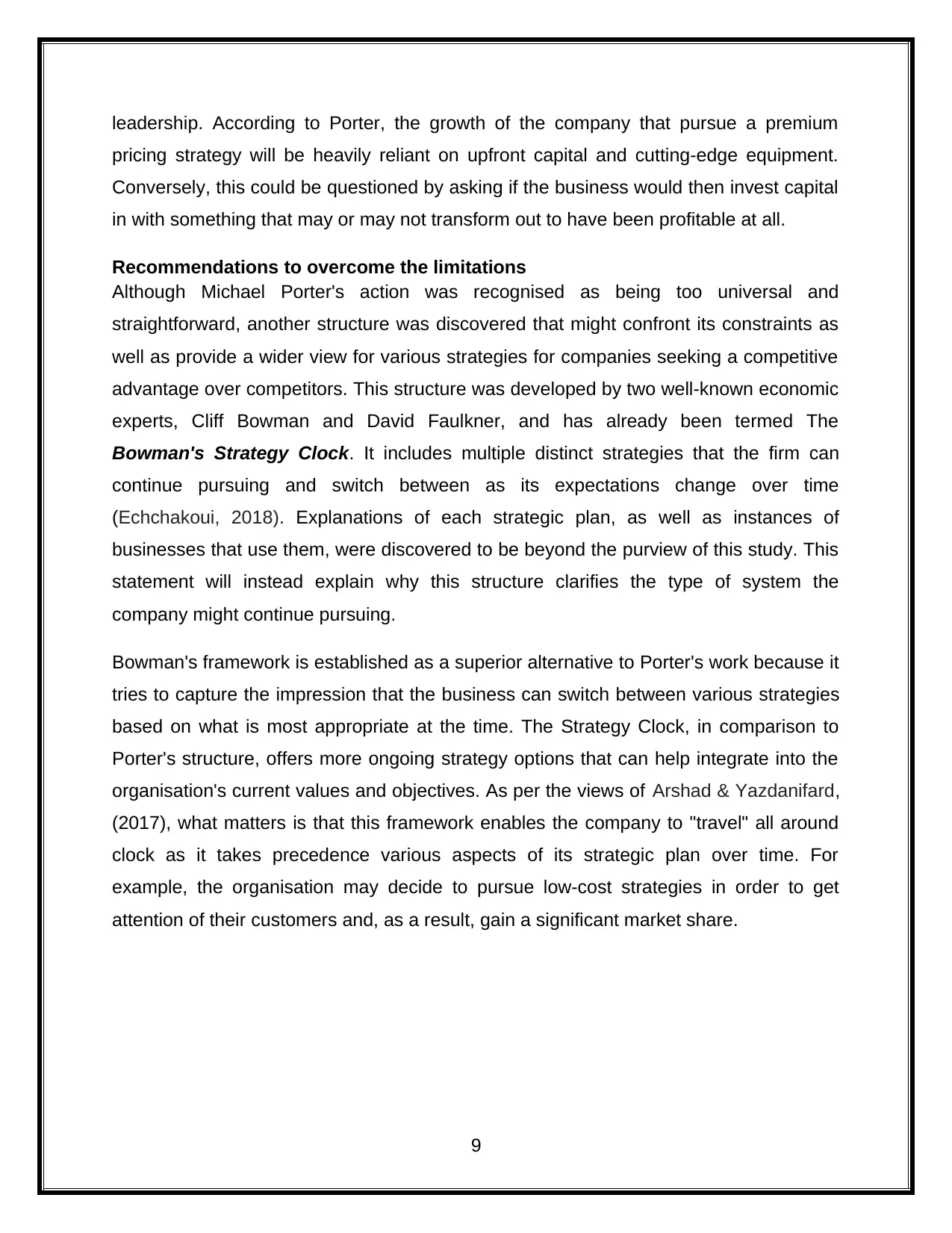
leadership. According to Porter, the growth of the company that pursue a premium
pricing strategy will be heavily reliant on upfront capital and cutting-edge equipment.
Conversely, this could be questioned by asking if the business would then invest capital
in with something that may or may not transform out to have been profitable at all.
Recommendations to overcome the limitations
Although Michael Porter's action was recognised as being too universal and
straightforward, another structure was discovered that might confront its constraints as
well as provide a wider view for various strategies for companies seeking a competitive
advantage over competitors. This structure was developed by two well-known economic
experts, Cliff Bowman and David Faulkner, and has already been termed The
Bowman's Strategy Clock. It includes multiple distinct strategies that the firm can
continue pursuing and switch between as its expectations change over time
(Echchakoui, 2018). Explanations of each strategic plan, as well as instances of
businesses that use them, were discovered to be beyond the purview of this study. This
statement will instead explain why this structure clarifies the type of system the
company might continue pursuing.
Bowman's framework is established as a superior alternative to Porter's work because it
tries to capture the impression that the business can switch between various strategies
based on what is most appropriate at the time. The Strategy Clock, in comparison to
Porter's structure, offers more ongoing strategy options that can help integrate into the
organisation's current values and objectives. As per the views of Arshad & Yazdanifard,
(2017), what matters is that this framework enables the company to "travel" all around
clock as it takes precedence various aspects of its strategic plan over time. For
example, the organisation may decide to pursue low-cost strategies in order to get
attention of their customers and, as a result, gain a significant market share.
9
pricing strategy will be heavily reliant on upfront capital and cutting-edge equipment.
Conversely, this could be questioned by asking if the business would then invest capital
in with something that may or may not transform out to have been profitable at all.
Recommendations to overcome the limitations
Although Michael Porter's action was recognised as being too universal and
straightforward, another structure was discovered that might confront its constraints as
well as provide a wider view for various strategies for companies seeking a competitive
advantage over competitors. This structure was developed by two well-known economic
experts, Cliff Bowman and David Faulkner, and has already been termed The
Bowman's Strategy Clock. It includes multiple distinct strategies that the firm can
continue pursuing and switch between as its expectations change over time
(Echchakoui, 2018). Explanations of each strategic plan, as well as instances of
businesses that use them, were discovered to be beyond the purview of this study. This
statement will instead explain why this structure clarifies the type of system the
company might continue pursuing.
Bowman's framework is established as a superior alternative to Porter's work because it
tries to capture the impression that the business can switch between various strategies
based on what is most appropriate at the time. The Strategy Clock, in comparison to
Porter's structure, offers more ongoing strategy options that can help integrate into the
organisation's current values and objectives. As per the views of Arshad & Yazdanifard,
(2017), what matters is that this framework enables the company to "travel" all around
clock as it takes precedence various aspects of its strategic plan over time. For
example, the organisation may decide to pursue low-cost strategies in order to get
attention of their customers and, as a result, gain a significant market share.
9
⊘ This is a preview!⊘
Do you want full access?
Subscribe today to unlock all pages.

Trusted by 1+ million students worldwide
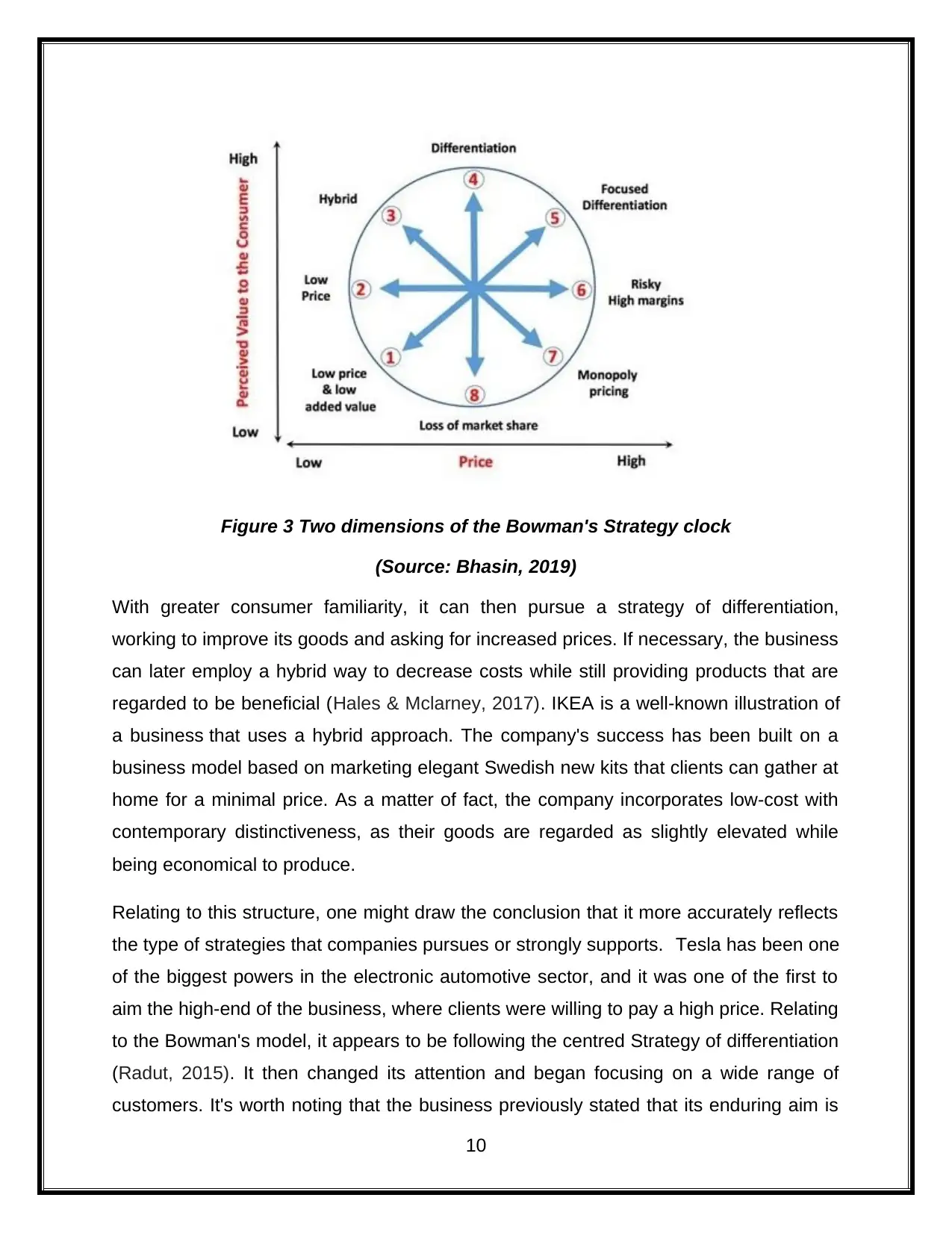
Figure 3 Two dimensions of the Bowman's Strategy clock
(Source: Bhasin, 2019)
With greater consumer familiarity, it can then pursue a strategy of differentiation,
working to improve its goods and asking for increased prices. If necessary, the business
can later employ a hybrid way to decrease costs while still providing products that are
regarded to be beneficial (Hales & Mclarney, 2017). IKEA is a well-known illustration of
a business that uses a hybrid approach. The company's success has been built on a
business model based on marketing elegant Swedish new kits that clients can gather at
home for a minimal price. As a matter of fact, the company incorporates low-cost with
contemporary distinctiveness, as their goods are regarded as slightly elevated while
being economical to produce.
Relating to this structure, one might draw the conclusion that it more accurately reflects
the type of strategies that companies pursues or strongly supports. Tesla has been one
of the biggest powers in the electronic automotive sector, and it was one of the first to
aim the high-end of the business, where clients were willing to pay a high price. Relating
to the Bowman's model, it appears to be following the centred Strategy of differentiation
(Radut, 2015). It then changed its attention and began focusing on a wide range of
customers. It's worth noting that the business previously stated that its enduring aim is
10
(Source: Bhasin, 2019)
With greater consumer familiarity, it can then pursue a strategy of differentiation,
working to improve its goods and asking for increased prices. If necessary, the business
can later employ a hybrid way to decrease costs while still providing products that are
regarded to be beneficial (Hales & Mclarney, 2017). IKEA is a well-known illustration of
a business that uses a hybrid approach. The company's success has been built on a
business model based on marketing elegant Swedish new kits that clients can gather at
home for a minimal price. As a matter of fact, the company incorporates low-cost with
contemporary distinctiveness, as their goods are regarded as slightly elevated while
being economical to produce.
Relating to this structure, one might draw the conclusion that it more accurately reflects
the type of strategies that companies pursues or strongly supports. Tesla has been one
of the biggest powers in the electronic automotive sector, and it was one of the first to
aim the high-end of the business, where clients were willing to pay a high price. Relating
to the Bowman's model, it appears to be following the centred Strategy of differentiation
(Radut, 2015). It then changed its attention and began focusing on a wide range of
customers. It's worth noting that the business previously stated that its enduring aim is
10
Paraphrase This Document
Need a fresh take? Get an instant paraphrase of this document with our AI Paraphraser
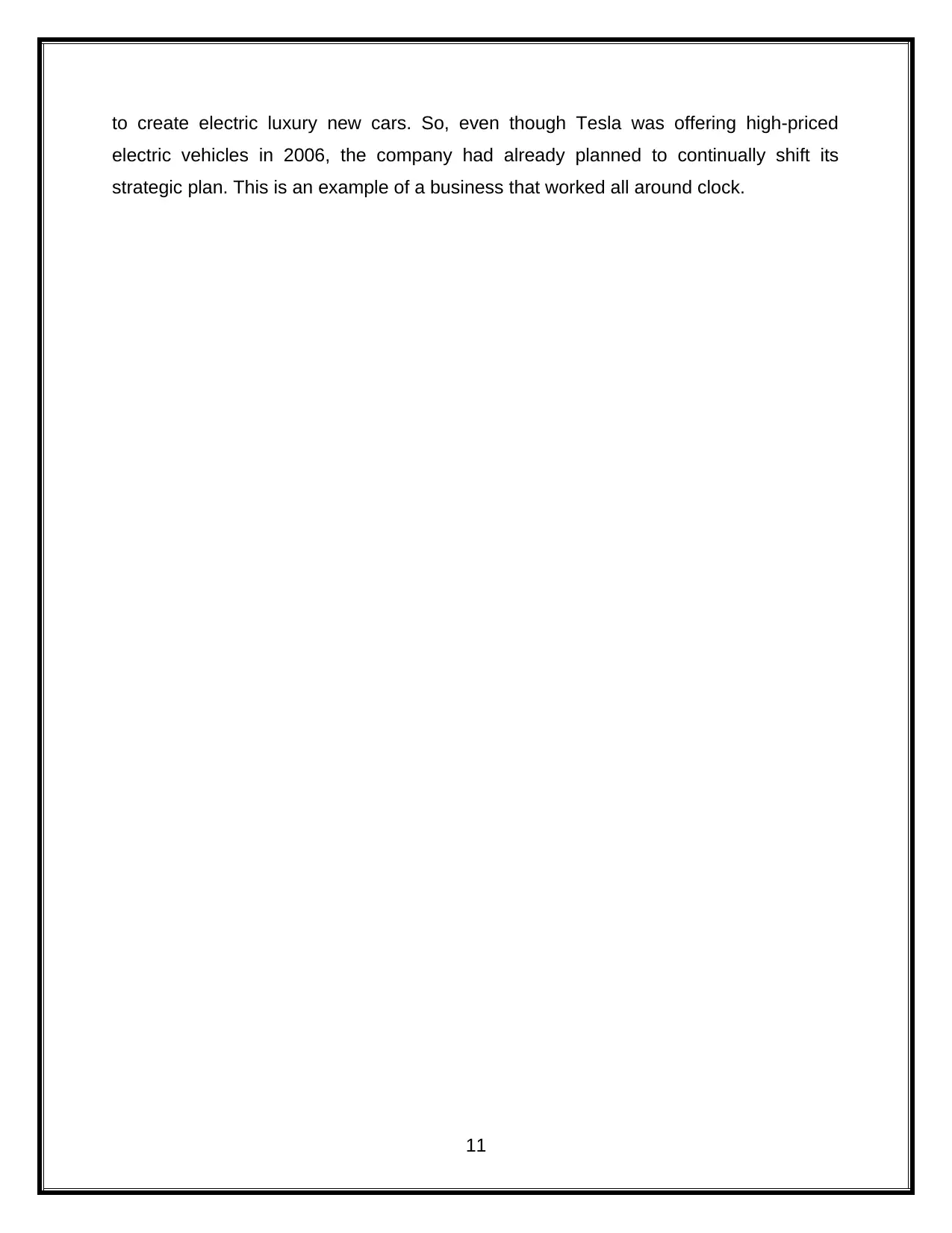
to create electric luxury new cars. So, even though Tesla was offering high-priced
electric vehicles in 2006, the company had already planned to continually shift its
strategic plan. This is an example of a business that worked all around clock.
11
electric vehicles in 2006, the company had already planned to continually shift its
strategic plan. This is an example of a business that worked all around clock.
11
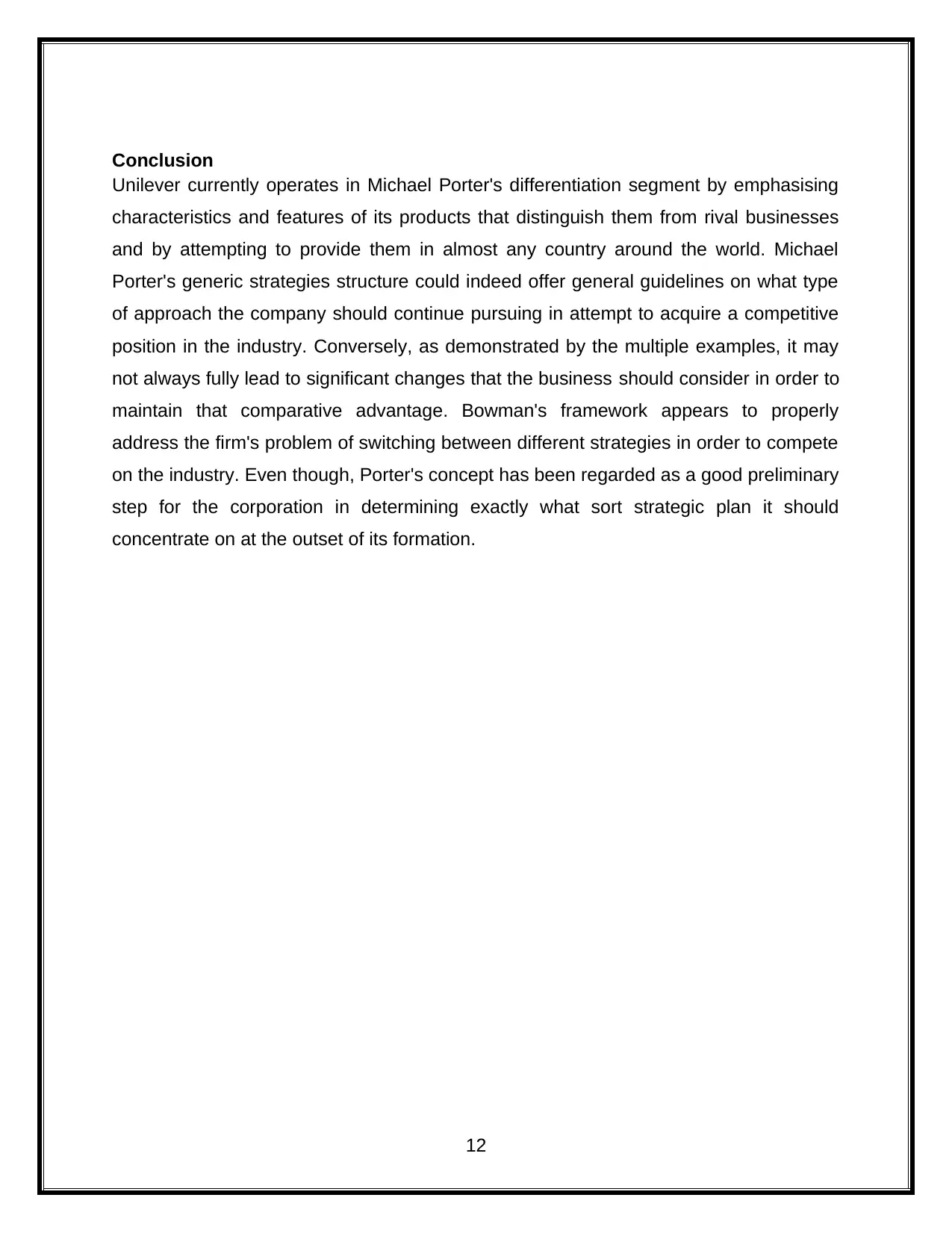
Conclusion
Unilever currently operates in Michael Porter's differentiation segment by emphasising
characteristics and features of its products that distinguish them from rival businesses
and by attempting to provide them in almost any country around the world. Michael
Porter's generic strategies structure could indeed offer general guidelines on what type
of approach the company should continue pursuing in attempt to acquire a competitive
position in the industry. Conversely, as demonstrated by the multiple examples, it may
not always fully lead to significant changes that the business should consider in order to
maintain that comparative advantage. Bowman's framework appears to properly
address the firm's problem of switching between different strategies in order to compete
on the industry. Even though, Porter's concept has been regarded as a good preliminary
step for the corporation in determining exactly what sort strategic plan it should
concentrate on at the outset of its formation.
12
Unilever currently operates in Michael Porter's differentiation segment by emphasising
characteristics and features of its products that distinguish them from rival businesses
and by attempting to provide them in almost any country around the world. Michael
Porter's generic strategies structure could indeed offer general guidelines on what type
of approach the company should continue pursuing in attempt to acquire a competitive
position in the industry. Conversely, as demonstrated by the multiple examples, it may
not always fully lead to significant changes that the business should consider in order to
maintain that comparative advantage. Bowman's framework appears to properly
address the firm's problem of switching between different strategies in order to compete
on the industry. Even though, Porter's concept has been regarded as a good preliminary
step for the corporation in determining exactly what sort strategic plan it should
concentrate on at the outset of its formation.
12
⊘ This is a preview!⊘
Do you want full access?
Subscribe today to unlock all pages.

Trusted by 1+ million students worldwide
1 out of 14
Related Documents
Your All-in-One AI-Powered Toolkit for Academic Success.
+13062052269
info@desklib.com
Available 24*7 on WhatsApp / Email
![[object Object]](/_next/static/media/star-bottom.7253800d.svg)
Unlock your academic potential
Copyright © 2020–2025 A2Z Services. All Rights Reserved. Developed and managed by ZUCOL.




